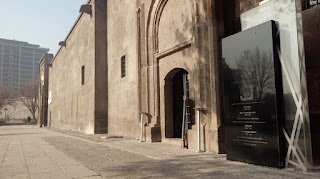I find myself in front of an un-impressive, grey building, a complex dating from the 13th century, comprising of two attached buildings: a hospital and a medical school (medrese), named after the princess of the Sultanate of Rum, Gevher Nesibe. What stands out are probably the two portals that facilitate the entrance to the two adjoining buildings, constructed in granite stone, typical for Seljuk architecture.
As soon as I enter, I notice that there’s a peaceful feeling about this place (partly due to the lack of visitors :)). Althougs the outside may seem like a huge garage, the inner structures and architectural lines are stunning, a meditative setting (that goes to show that you shouldn’t read a book by its cover).
The bittersweet legend that tells the story of how this building came to be goes like this: seemingly Gevher Nesibe fell in love with a cavalry officer defending the palace of the Seljuk sultan at Konya, but her brother opposed marriage between the two and had the officer sent on various dangerous assignments to ensure his death. Overcome with grief and longing at her lover's death, the princess fell ill with tuberculosis. Her brother, feeling remorseful, visited her on her deathbed to ask for forgiveness and offered to fulfill any last request she had. Gevher Nesibe is reported to have asked that a hospital would be built in her memory, where sick people should be treated free of charge and also incurable illnesses would be treated.
As I browse the rooms, I realize that, although the the old museum was all about medicine, both human and animal, the updated museum seems to provide more information on the Selcuk Empire, a small but varied collection of artifacts alongside an explanation of Seljuk history, art and medicine. You will notice right away that there’s little or nothing written in English so, if you can’t speak Turkish, it might be a good idea to do your homework ahead of time, otherwise you can easily miss key details.
There are rooms for musical and water therapy ( in those early days, physicians treated mental illness and psychiatric conditions either spiritually or using music therapy), mockups of how the practitioner and patient work together and interact and wide common open air rooms.
It is fascinating to see the early surgical instruments and wander through the water therapy areas that give evidence to these ancient approaches to mental and physical health.
I was taken aback at the sight of those tiny cells in which the violent patients of the mental illness hospital were kept in, luckily the sun has set on those ancient practices!
There are also some interactive features and maps and a clever use of sound and light to evoke the atmosphere of ancient times. What I also enjoyed were the exhibits for the blind accompanied by Braille.
Find the time to go there, it's like taking a leap in time, and when you come to think we've come such a long way... All in all, a great way to spend my morning (or as the social networks would put it: "LIKE")!













No comments:
Post a Comment